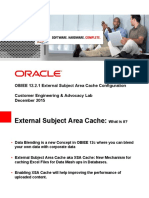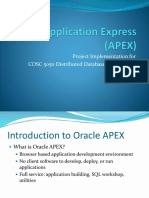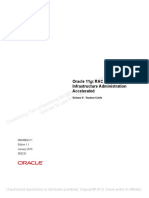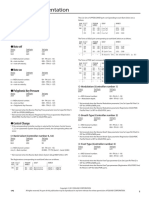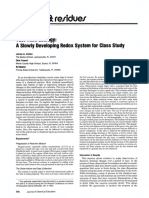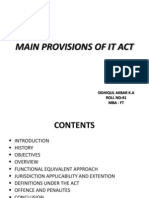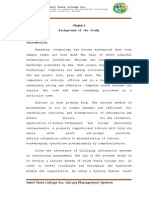D48291GC10 - 02 - Common Concepts
D48291GC10 - 02 - Common Concepts
Uploaded by
LakshmiNarayana PuttamchettyCopyright:
Available Formats
D48291GC10 - 02 - Common Concepts
D48291GC10 - 02 - Common Concepts
Uploaded by
LakshmiNarayana PuttamchettyOriginal Title
Copyright
Available Formats
Share this document
Did you find this document useful?
Is this content inappropriate?
Copyright:
Available Formats
D48291GC10 - 02 - Common Concepts
D48291GC10 - 02 - Common Concepts
Uploaded by
LakshmiNarayana PuttamchettyCopyright:
Available Formats
2
D48291GC10 ORACLE Utilities Customer Care &
Billing Configuration Ed 1
Module 02 Common Concepts
Copyright 2008, Oracle. All rights reserved.
Objectives
After completing this Architecture module, you should be
able to:
Understand the role of the CC&B Administration
account.
Understand the concept of an "environment"
Understand the concept of attaching to an
environment.
Understand the directory structure of an environment.
Understand the common environment variables used in
CC&B.
Understand the basic URL's used for CC&B.
2-2
Copyright 2008, Oracle. All rights reserved.
CC&B Administrator Account
Default CC&B administrator account: cissys
The administrator account is needed to install the product.
Responsibilities:
Owner of structure
Owner of configuration
Start, shutdown and monitor product.
This userid is NOT responsible for:
Does not run CC&B background processes.
Does not access online product.
Treat the account as you would the root account.
2-3
Copyright 2008, Oracle. All rights reserved.
Implementation Tip: Multiple Owners
It is possible to assign an owner per copy of CC&B
Advantages:
Delegation of responsibility for non-production.
Segregation of resources.
Disadvantages:
You must login using that user to manage that copy of
CC&B.
How can this be done?
User/directories must be setup with the correct
permissions.
Access to /etc/cistab must be allowed
Make sure user installs that particular copy of CC&B.
2-4
Copyright 2008, Oracle. All rights reserved.
What is an CC&B environment?
A CC&B environment is
defined as a distinct copy
of CC&Bs database and
Web Application Server
A copy of the base
product
A copy of the
customizations
installed alongside the
base.
Remember the CC&B
Architecture
2-5
Web Application Server
Business Application Server
Database Server
Copyright 2008, Oracle. All rights reserved.
Implementation Tip: Environment Management
Choose an appropriate name/identifier for it.
Assign an environment owner.
Agree de-installation date for environment.
Agree availability of environment (24x7, business hours,
adhoc etc).
Agree maintenance windows for environment.
Agree backup regime for environment.
Agree security procedures for environment.
Record this all somewhere
2-6
Copyright 2008, Oracle. All rights reserved.
Environment Retention
Each environment should have a de-installation date (even
if the value is perpetual).
Negotiate and record the date in your documentation.
Setting dates can force thought on environment
rationalization.
This is important.
2-7
Copyright 2008, Oracle. All rights reserved.
Attaching to an environment
This sets the environment variables necessary for execution of
utilities.
Change to the environments bin directory.
Use the following command to attach to the environment.
splenviron.sh
e (SPLVERSION)
<environment>
[-c <command>] [-q] [-v] [-h]
Version
................
: V2.1.x
Database Type ............... (SPLDB) : oracle
splenviron.cmd e <environment> [-c <command>] [q] [-v] [-h]
ORACLE_SID ............. (ORACLE_SID) : SPLDEMO
NLS_LANG ................. (NLS_LANG) : AMERICAN_AMERICA.WE8ISO8859P15
Environment Name ....... (SPLENVIRON) : CCBTRAIN
Environment Code Directory (SPLEBASE) : /spl/CCBTRAIN
App Output Dir - Logs ... (SPLOUTPUT) : /spl/sploutput/CCBTRAIN
Build Directory .......... (SPLBUILD) : /spl/CCBTRAIN/cobol/build
Runtime Directory .......... (SPLRUN) : /spl/CCBTRAIN/runtime
Cobol Copy Path ......... (SPLCOBCPY) : /spl/CCBTRAIN/cobol/source/cm;/spl/CCBTRAIN/
services;/spl/CCBTRAIN/cobol/source
This must be performed before any administration commands can be performed
2-8
Copyright 2008, Oracle. All rights reserved.
Directory Structure - Environment
CC&B mount point (usually /spl or <drive>:\spl)
<SPLDIR>
$SPLEBASE or %SPLEBASE%
<environment name>
Binaries and utility scripts
bin
COBOL Build directories
cobol
Configuration files
etc
conf
metadata
SF
Meta Data build directory (compilation only)
Single Fix build directory (compilation only)
Active logs
logs
system
product
runtime
scripts
services
splapp
2-9
Web Application configuration files
System startup/shutdown logs
Other product subdirectory (Perl, Ant, Tomcat)
Business object runtimes
Custom scripts for batch jobs
Source for Services/Plugins
Web Application Server files
Copyright 2008, Oracle. All rights reserved.
Directory Structure Output
<SPLOUTPUT>
Application output mount point (e.g. /spl/sploutput or <drive>:\spl\sploutput)
<environment name>
$SPLOUTPUT
Directory for all application and log files in this environment
2 - 10
Copyright 2008, Oracle. All rights reserved.
Implementation Tip: Multiple Environments
On non-production you will
have multiple environments.
All separated by directories.
/spl
TEST1
TEST2
TEST3
sploutput
TEST1
TEST2
TEST3
2 - 11
Copyright 2008, Oracle. All rights reserved.
Common Environment variables
2 - 12
Variable
Usage
SPLADMIN
CC&B Administrator account for this environment
SPLADMINGROUP
CC&B Administrator group for this environment
SPLBUILD
COBOL Build directory (used for compilation)
SPLCOBCPY
COBOL Copy book path (used for compilation)
SPLDB
Database type used for this environment
SPLEBASE
Root location of the CC&B software
SPLENVIRON
Name of environment used for installation
SPLOUTPUT
Root location of CC&B output files
SPLRUN
CC&B Runtime
SPLSOURCE
COBOL source (used for compilation)
SPLSYSTEMLOGS
Location of CC&B Log files
SPLVERSION
Framework Version
SPLVERSIONFILE
Location of Application Framework Version file
SPLWAS
Web Application Server type
Copyright 2008, Oracle. All rights reserved.
Implementation Tip: Adding your own settings
It is possible to add your own environment settings
when splenviron.sh or splenviron.cmd is run.
Locally:
Create cmenv.sh or cmenv.cmd and place it in the
scripts directory under SPLEBASE.
Globally:
Set the CMENV environment variable prior to
running splenviron to point to a global script.
2 - 13
Copyright 2008, Oracle. All rights reserved.
Important URLs
The following URLs are important to remember:
CC&B main URL
http://<machine>:<port>/SPLApp/cis.jsp
CC&B with debug facilities
http://<machine>:<port>/SPLApp/cis.jsp?debug=true
Where:
<machine> - Web Application Server Machine
<port> - Port number allocated to an environment for Web
application Server.
2 - 14
Copyright 2008, Oracle. All rights reserved.
Administration of the cache
2 - 15
URL
Usage
flushAll.jsp
Clears the whole cache
flushDropdownCache.jsp
Clears ALL the Drop Down data from cache
flushDropDownField.jsp
Clears specific Drop Down data (needs Field
name)
flushFieldAndFKMetaData.jsp
Clears Literals and FK relationships from
cache
flushMenu.jsp
Clears Menu items from cache
flushMessageCatalog.jsp
Clears Message texts from cache
flushMessaging.jsp
Clears XAI Sender information from cache
flushNavigationInfo.jsp
Clears Navigation Keys from cache
flushPortalMetaInfo.jsp
Clears Portal information from cache
flushSystemLoginInfo.jsp
Clears security information from cache
flushUI_XSLs.jsp
Clears style sheets from cache
Copyright 2008, Oracle. All rights reserved.
Summary
In this Common Concepts module, you should have
learned how to:
Understand the role of the CC&B Administration
account.
Understand the concept of an "environment"
Understand the concept of attaching to an
environment.
Understand the directory structure of an environment.
Understand the common environment variables used in
CC&B.
Understand the basic URL's used for CC&B.
2 - 16
Copyright 2008, Oracle. All rights reserved.
Any Questions?
2 - 17
Q&
A
Copyright 2008, Oracle. All rights reserved.
2 - 18
Copyright 2008, Oracle. All rights reserved.
2 - 19
Copyright 2008, Oracle. All rights reserved.
You might also like
- Obiee Activity GuideDocument320 pagesObiee Activity GuideMadhavi SadhuNo ratings yet
- Red Hat OpenShift The Ultimate Step-By-Step GuideFrom EverandRed Hat OpenShift The Ultimate Step-By-Step GuideRating: 1 out of 5 stars1/5 (1)
- Lovato Direct InjectionDocument22 pagesLovato Direct InjectionZoli Borbely0% (1)
- D48291GC10 - 03 - Configuration OperationsDocument12 pagesD48291GC10 - 03 - Configuration OperationsLakshmiNarayana PuttamchettyNo ratings yet
- D48291GC10 - 07 - Security ConfigurationDocument13 pagesD48291GC10 - 07 - Security ConfigurationLakshmiNarayana PuttamchettyNo ratings yet
- D48291GC10 - 04 - Client ConfigurationDocument13 pagesD48291GC10 - 04 - Client ConfigurationLakshmiNarayana Puttamchetty100% (1)
- Can Oracle GoldenGate Be Used To Replicate SAP Data (Doc ID 1269452.1)Document265 pagesCan Oracle GoldenGate Be Used To Replicate SAP Data (Doc ID 1269452.1)YasirNo ratings yet
- Complete Installation and Configuration of Oracle Data IntegratorDocument33 pagesComplete Installation and Configuration of Oracle Data IntegratorDinesh ReddyNo ratings yet
- How To Enter and Query Arabic Characters Into or From Database Via Forms ApplicationDocument2 pagesHow To Enter and Query Arabic Characters Into or From Database Via Forms ApplicationSHAHID FAROOQNo ratings yet
- OBIEE 12.2.1 External Subject Area Cache ConfigurationDocument11 pagesOBIEE 12.2.1 External Subject Area Cache ConfigurationSandeep KulkarniNo ratings yet
- ODI 12c - SCMDocument45 pagesODI 12c - SCMAsad HussainNo ratings yet
- D48293GC10 - ORACLE Utilities Customer Care & Billing - Operations Ed 1Document6 pagesD48293GC10 - ORACLE Utilities Customer Care & Billing - Operations Ed 1LakshmiNarayana PuttamchettyNo ratings yet
- OracleWebLogicServer 12c Admin 1 StudentGuide Vol 1Document340 pagesOracleWebLogicServer 12c Admin 1 StudentGuide Vol 1Naresh SundaraneediNo ratings yet
- D53979GC20 AgDocument386 pagesD53979GC20 AgWinMeo DíazNo ratings yet
- D63510GC20 AgDocument320 pagesD63510GC20 AgDavid Delacruz BarreraNo ratings yet
- Oracle Weblogic Portal 10G R3: System Administration: D58824Gc10 Edition 1.0 September 2009 D62293Document18 pagesOracle Weblogic Portal 10G R3: System Administration: D58824Gc10 Edition 1.0 September 2009 D62293Rapid ChaseNo ratings yet
- Oracle Database 11g: SQL Fundamentals I: D49996GC10 Edition 1.0 August 2007 D52128Document14 pagesOracle Database 11g: SQL Fundamentals I: D49996GC10 Edition 1.0 August 2007 D52128Saqib JuttNo ratings yet
- Oracle DocsDocument241 pagesOracle Docsdaniel_marin19326No ratings yet
- Project Implementation For COSC 5050 Distributed Database Applications Lab1Document18 pagesProject Implementation For COSC 5050 Distributed Database Applications Lab1sarithaNo ratings yet
- Apex IntegrationDocument2 pagesApex IntegrationMushtaq AhmedNo ratings yet
- OPSS ConfigurationDocument18 pagesOPSS Configurationhareesh_jhNo ratings yet
- SQL Practical Test 2 Semester 2, 2014 ISCG5423 Introduction To DatabasesDocument15 pagesSQL Practical Test 2 Semester 2, 2014 ISCG5423 Introduction To DatabasesNirmalNo ratings yet
- Plan Oracle 0112-0612 131011Document2 pagesPlan Oracle 0112-0612 131011mail4prabhakarNo ratings yet
- D17075GC10 TocDocument12 pagesD17075GC10 TocrameshibmNo ratings yet
- D56780GC11 Ag PDFDocument184 pagesD56780GC11 Ag PDFSatyajeet ReddyNo ratings yet
- Installing Oracle Application Server 11g R1 On CentOSDocument13 pagesInstalling Oracle Application Server 11g R1 On CentOSNguyen Quoc Huy100% (3)
- Oracle Goldengate 11G Troubleshooting and Tuning: D66531Gc20 Edition 2.0 December 2012 D80108Document8 pagesOracle Goldengate 11G Troubleshooting and Tuning: D66531Gc20 Edition 2.0 December 2012 D80108JAYANo ratings yet
- Department of Computing: Final Examination Semester 1, 2012 ISCG5423 Introduction To DatabasesDocument7 pagesDepartment of Computing: Final Examination Semester 1, 2012 ISCG5423 Introduction To DatabasesNirmalNo ratings yet
- Oracle Database 11g BI and Data Warehousing D52358Document104 pagesOracle Database 11g BI and Data Warehousing D52358exodeeNo ratings yet
- D48291GC10 - 01 - ArchitectureDocument21 pagesD48291GC10 - 01 - ArchitectureLakshmiNarayana PuttamchettyNo ratings yet
- Enterprise Workforce Structure - Ag 21cDocument86 pagesEnterprise Workforce Structure - Ag 21cBrijeshNo ratings yet
- OBIEE 11g - Bootcamp (AG) PDFDocument62 pagesOBIEE 11g - Bootcamp (AG) PDFjeedNo ratings yet
- HCM92ERDInstructions FinalDocument8 pagesHCM92ERDInstructions FinalmanedeepNo ratings yet
- R12 Building OA Framework Applications: Implementing A CreateDocument15 pagesR12 Building OA Framework Applications: Implementing A CreateKhaled-ASNo ratings yet
- Oracle Autoview EnoviaDocument44 pagesOracle Autoview EnoviakoollkkNo ratings yet
- Oracle WebLogic Server Integration With Oracle Database 12cDocument31 pagesOracle WebLogic Server Integration With Oracle Database 12celidaNo ratings yet
- D80190GC11 Ep (PresentacionesTodas)Document483 pagesD80190GC11 Ep (PresentacionesTodas)StevenandresElfoNo ratings yet
- BI Publisher - 8Document61 pagesBI Publisher - 8Percy PerezNo ratings yet
- 01OBI11G ArchitectureDocument18 pages01OBI11G ArchitecturemanuNo ratings yet
- OBI Apps 11gDocument31 pagesOBI Apps 11grao_jayeshNo ratings yet
- OBIEE 11g Analytics Using EMC Greenplum Database: - An Integration Guide For OBIEE 11g Windows UsersDocument16 pagesOBIEE 11g Analytics Using EMC Greenplum Database: - An Integration Guide For OBIEE 11g Windows UsersmlgovardhanNo ratings yet
- Oracle Apex Installation GuideDocument143 pagesOracle Apex Installation GuideanandNo ratings yet
- Linux Commands For OBIEEDocument15 pagesLinux Commands For OBIEErishiraj_rathor7550No ratings yet
- Using Oracle Enterprise Manager Cloud Control 13c Ed 2: DurationDocument4 pagesUsing Oracle Enterprise Manager Cloud Control 13c Ed 2: DurationBugz BinnyNo ratings yet
- D97103GC10 AgDocument394 pagesD97103GC10 AglferdjiNo ratings yet
- license to use this Student Guideฺ: Oracle 11g: RAC and Grid Infrastructure Administration AcceleratedDocument468 pageslicense to use this Student Guideฺ: Oracle 11g: RAC and Grid Infrastructure Administration AcceleratedPeiChin GoNo ratings yet
- D72965GC30 sg2 PDFDocument390 pagesD72965GC30 sg2 PDFkam_chan_syd7562No ratings yet
- OracleDatabase 11g PerformanceTunning StudentGuide Vol IIDocument370 pagesOracleDatabase 11g PerformanceTunning StudentGuide Vol IINaresh SundaraneediNo ratings yet
- How To Use The Grinder Performance Testing ToolDocument18 pagesHow To Use The Grinder Performance Testing Toolitishajain23No ratings yet
- Character Set Change in DBDocument8 pagesCharacter Set Change in DBvenkatNo ratings yet
- Oracle OBIEE 12c Tuning Guide - V2Document60 pagesOracle OBIEE 12c Tuning Guide - V2nareshreddyguntakaNo ratings yet
- Oracle Database 10G: Managing Oracle On Linux For Dbas: D46590Gc10 Edition 1.0 January 2007 D49271Document272 pagesOracle Database 10G: Managing Oracle On Linux For Dbas: D46590Gc10 Edition 1.0 January 2007 D49271fmanyan12No ratings yet
- Pro Oracle SQL Development: Best Practices for Writing Advanced QueriesFrom EverandPro Oracle SQL Development: Best Practices for Writing Advanced QueriesNo ratings yet
- Oracle Solaris 11 System Virtualization Complete Self-Assessment GuideFrom EverandOracle Solaris 11 System Virtualization Complete Self-Assessment GuideNo ratings yet
- Oracle SOA BPEL Process Manager 11gR1 A Hands-on TutorialFrom EverandOracle SOA BPEL Process Manager 11gR1 A Hands-on TutorialRating: 5 out of 5 stars5/5 (1)
- The Business Analyst's Guide to Oracle Hyperion Interactive Reporting 11From EverandThe Business Analyst's Guide to Oracle Hyperion Interactive Reporting 11Rating: 5 out of 5 stars5/5 (1)
- WKBKCCB 05 BO Business RulesDocument11 pagesWKBKCCB 05 BO Business RulesLakshmiNarayana PuttamchettyNo ratings yet
- WKBKCCB 07 BO LifecycleDocument17 pagesWKBKCCB 07 BO LifecycleLakshmiNarayana PuttamchettyNo ratings yet
- WKBKCCB 04 BO ElementsDocument10 pagesWKBKCCB 04 BO ElementsLakshmiNarayana PuttamchettyNo ratings yet
- 17 BPA ScriptsDocument79 pages17 BPA ScriptsLakshmiNarayana Puttamchetty100% (1)
- WKBKCCB 03 Tech Overview WorkbookDocument5 pagesWKBKCCB 03 Tech Overview WorkbookLakshmiNarayana PuttamchettyNo ratings yet
- WkbkCCB-02-Product Strategy Requirement - 11041 Adjustment ApprovalDocument4 pagesWkbkCCB-02-Product Strategy Requirement - 11041 Adjustment ApprovalLakshmiNarayana PuttamchettyNo ratings yet
- WKBKCCB 04 BO ElementsDocument10 pagesWKBKCCB 04 BO ElementsLakshmiNarayana PuttamchettyNo ratings yet
- 07 BO LifecycleDocument56 pages07 BO LifecycleLakshmiNarayana PuttamchettyNo ratings yet
- 11 Business ServicesDocument28 pages11 Business ServicesLakshmiNarayana PuttamchettyNo ratings yet
- 14 Info ZonesDocument46 pages14 Info ZonesLakshmiNarayana PuttamchettyNo ratings yet
- 10 Service ScriptsDocument26 pages10 Service ScriptsLakshmiNarayana PuttamchettyNo ratings yet
- XAI Best PracticesDocument106 pagesXAI Best PracticesLakshmiNarayana PuttamchettyNo ratings yet
- Oracle Utilities Customer Care and Billing: Business Process Guide 2 Release 2.3.1Document414 pagesOracle Utilities Customer Care and Billing: Business Process Guide 2 Release 2.3.1LakshmiNarayana PuttamchettyNo ratings yet
- D48293GC10 - ORACLE Utilities Customer Care & Billing - Operations Ed 1Document6 pagesD48293GC10 - ORACLE Utilities Customer Care & Billing - Operations Ed 1LakshmiNarayana PuttamchettyNo ratings yet
- D48291GC10 - 01 - ArchitectureDocument21 pagesD48291GC10 - 01 - ArchitectureLakshmiNarayana PuttamchettyNo ratings yet
- Oracle Utilities Customer Care and Billing: Business Process Guide Release 2.3.1Document418 pagesOracle Utilities Customer Care and Billing: Business Process Guide Release 2.3.1LakshmiNarayana PuttamchettyNo ratings yet
- LAB612Document108 pagesLAB612atreus ccNo ratings yet
- Parul Institute of Engineering and Technology Faculty of Engineering and Technology Department of Information TechnologyDocument15 pagesParul Institute of Engineering and Technology Faculty of Engineering and Technology Department of Information Technologyharsh PatelNo ratings yet
- RGB Encoder: This Is Not An Official Sony Document!Document5 pagesRGB Encoder: This Is Not An Official Sony Document!Rumen J.No ratings yet
- E Mail Marketing Project Postwell Services 123456Document53 pagesE Mail Marketing Project Postwell Services 123456huneet SinghNo ratings yet
- 7705 SAR OS Services GuideDocument70 pages7705 SAR OS Services GuideClaudia DombroskiNo ratings yet
- 1 PS2 Group 3 Project Proposal FormDocument4 pages1 PS2 Group 3 Project Proposal FormKimberly M. EspelitaNo ratings yet
- LTE Advanced PlanningDocument98 pagesLTE Advanced Planningহাসিব মাহমুদNo ratings yet
- JUPITER-80 ManualDocument26 pagesJUPITER-80 ManualLucas HarimNo ratings yet
- Test Tube GeologyDocument2 pagesTest Tube GeologyJavier Andres Esteban MuñozNo ratings yet
- Main Provisions of It Act 41Document15 pagesMain Provisions of It Act 41Sidhique AkbarNo ratings yet
- ZXUR 9000 UMTS V4 11 20 Commissioning Guide Quick Data Configuration R1 4 PDFDocument94 pagesZXUR 9000 UMTS V4 11 20 Commissioning Guide Quick Data Configuration R1 4 PDFnazilaNo ratings yet
- Indian Institute of Technology Roorkee Department of Electrical EngineeringDocument5 pagesIndian Institute of Technology Roorkee Department of Electrical EngineeringJayant ChoudharyNo ratings yet
- Module in English 7: Scuola Madonna Della ScalaDocument3 pagesModule in English 7: Scuola Madonna Della ScalaJaq QuesNo ratings yet
- REFRATOMETRODocument80 pagesREFRATOMETROJohnatas GamaNo ratings yet
- Total Recall For Children: Irish Fisherman Survives 30 Minutes in Icy Waters After Falling OverboardDocument1 pageTotal Recall For Children: Irish Fisherman Survives 30 Minutes in Icy Waters After Falling Overboardapi-211285027No ratings yet
- 3DS Max 2011 ShortcutsDocument16 pages3DS Max 2011 ShortcutsLeonardoPelegrini100% (1)
- PlumePack ChangelogDocument7 pagesPlumePack ChangelogMontage NAPNo ratings yet
- OOP Using Python Hands-On AssessmentDocument10 pagesOOP Using Python Hands-On AssessmentSonakshi ChoudharyNo ratings yet
- Contoh Matrix Perbandingan Pasangan Dengan AHP (Analitic Hierarchy Process)Document27 pagesContoh Matrix Perbandingan Pasangan Dengan AHP (Analitic Hierarchy Process)Farol Raji PaRrNo ratings yet
- HSBC Fraud Guide - HSBC Bank PLCDocument9 pagesHSBC Fraud Guide - HSBC Bank PLCsampaio2710No ratings yet
- Public Service ICT Risk Management Toolkit GuideDocument12 pagesPublic Service ICT Risk Management Toolkit GuideNathanNo ratings yet
- Hive Infrastructure SwitchbladeDocument10 pagesHive Infrastructure SwitchbladeShashank SnNo ratings yet
- Library Management System (SAD)Document36 pagesLibrary Management System (SAD)Jayson Basiag33% (6)
- Noa 2022Document2 pagesNoa 2022Godsent CollectionsNo ratings yet
- Research Analyst in TCS Corporate Market Research TeamDocument1 pageResearch Analyst in TCS Corporate Market Research TeamPk Jha100% (1)
- Flexman 4 - 1 Installation and Configuration GuideDocument32 pagesFlexman 4 - 1 Installation and Configuration GuideManny MendozaNo ratings yet
- Toshiba Satellite Pro A 120 UserGuideDocument276 pagesToshiba Satellite Pro A 120 UserGuideVenkat EswarNo ratings yet
- Optical Sensors3Document10 pagesOptical Sensors3Csaba VargaNo ratings yet












